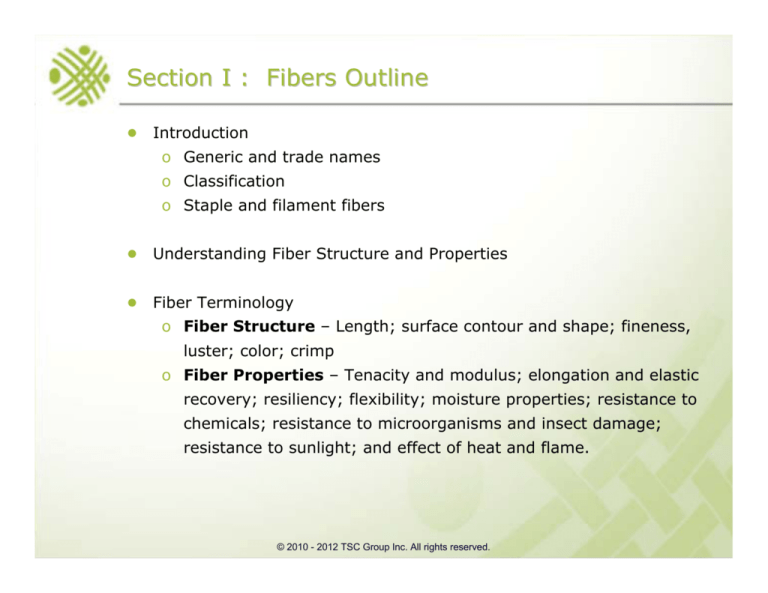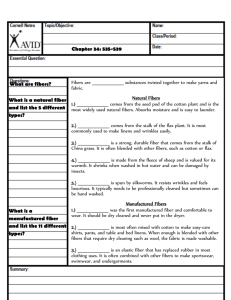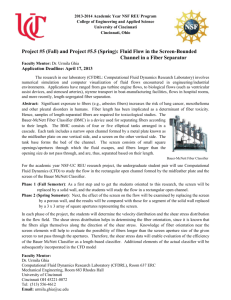
Section I : Fibers Outline
● Introduction
o Generic and trade names
o Classification
o Staple and filament fibers
● Understanding Fiber Structure and Properties
● Fiber Terminology
o Fiber Structure – Length; surface contour and shape; fineness,
luster; color; crimp
o Fiber Properties – Tenacity and modulus; elongation and elastic
recovery; resiliency; flexibility; moisture properties; resistance to
chemicals; resistance to microorganisms and insect damage;
resistance to sunlight; and effect of heat and flame.
© 2010 - 2012 TSC Group Inc. All rights reserved.
About Fibers
● Fiber
o Fundamental unit of all textile products
o Found in nature and also manufactured from various raw
materials
o Classified into natural and manufactured fibers
About Fibers
● Generic Names
o Defined by the Federal Trade Commission
o For natural fibers - based on fiber source
o For manufactured fibers - based on the chemical composition
o Basis for fiber classification
o Required on labels (see section on regulations)
● Trade Names
o Assigned by fiber manufacturers
trade name
generic name
Textile Fibers
Manufactured Fibers
Natural Fibers
Regenerated
Cellulose
Regenerated
Protein
Rayon
Lyocell
Azlon
Cellulose
Protein
Mineral
Seed Hair
Animal Hair
Asbestos*
Cotton
Wool
Kapok
Specialty Wool
Milkweed
Fur Fibers
Cellulose
Derivatives
Bast
Extruded
Acetate
Triacetate
Flax (Linen)
Ramie
Hemp
Jute
Leaf
Sisal
Abaca
Piña
Raffia
Fruit Husk
Coir
Silk
Spider Silk
ISO names are not as FTC generic names but
permitted by FTC on product labels
Alginate
Carbon
Chlorofibre
Cupro (cuprammonium included under rayon)
Elastane (same as spandex)
Elastodiene
Fluorofibre (same as fluoropolymer)
Metal Fibre (same as metallic)
Modal (included under rayon)
Polyamide (same as nylon)
Polyethylene (included under olefin)
Polyimide
Polypropylene (included under olefin)
Vinylal
Viscose (included under rayon)
Fibers commonly used for apparel and interiors are in bold
* asbestos not used for health reasons
** FTC definition includes natural and synthetic rubber
Synthetic
Petroleum
Rubber
Rubber**
Lastrile
Nylon
Polyester
Elasterell-p
Triexta (PTT)
Acrylic
Modacrylic
Spandex
Olefin
Lastol
Aramid
Nytril
Vinal
Vinyon
Anidex
Novoloid
Sulfar
Elastoester
Other
PBI
Melamine
Fluoropolymer
PLA
Mineral
Metallic
Glass
Staple and Filament Fibers
● Fibers differentiated based on length
o Staple fibers
o Filament fibers
staple fibers
filament fibers
● Length determines the methods used for processing
Staple and Filament Fibers
● Staple: short fibers (ranging from <1” to a few inches)
o All natural fibers (except silk) are staple fibers
o Manufactured fibers can be cut into staple fibers
● Filament: long continuous fibers extending for great lengths
(several hundred yards)
o Silk is the only natural filament fiber
o All manufactured fibers are produced as filament fibers
Fiber Structure and Properties
● Fiber Structure
o Appearance characteristics visible without a microscope
(e.g., fiber length, color)
o And with a microscope (e.g., cross-section)
● Fiber Properties
o Physical, chemical, moisture, biological and other
o Dependent on the large molecules, called polymers,
from which the fibers are made
Fiber Structure
Fixed for natural fibers; engineered for manufactured fibers
• Length
• Surface Contour and Shape
• Fineness
• Luster
• Color
• Crimp
Fiber Structure Terminology
● Fiber Length
o Length of staple fibers varies by source of fiber and variety/breed
o Used to determine the quality
o Important for processing staple fibers into yarns
● Surface Contour (Longitudinal View) and Shape (Cross-section)
o Used to identify natural fibers
o Can be changed in manufactured fibers to influence performance
Fiber Structure Terminology
● Fineness
o Size or diameter
o Used to determine the quality
o Measured in manufactured fibers by weighing a known length of
the continuous uniform fiber
Fiber Structure Terminology
● Luster
o Sheen or shine
o Depends on light reflected from
the surface
● Color
o Depends on fiber source
o Most are white or off-white
● Crimp
o Fiber’s waviness
o Some fibers have natural waviness
o Manufactured fibers can be
crimped to improve cohesiveness
Fiber Properties Terminology
● Tenacity
o Fiber’s strength per unit size
o Affects the strength of yarns and fabrics made from these
yarns
o Affects durability
● Modulus
o Fiber’s resistance to extension
o High modulus is important for end uses such as seatbelts
Fiber Properties Terminology
● Elongation
o Ability to extend when pulled along length until fiber breaks
(Note: The example below is to demonstrate elongation; the fiber
was not stretched to breaking point.)
Fiber Properties Terminology
● Elastic Recovery
o Fiber’s ability to return to its original length after it has been
stretched
o Affects stretch and shape retention properties of fabrics as well as
comfort and appearance
Fiber Properties Terminology
● Resilience
o Ability to recover after compression (e.g., crushed, crumpled,
twisted)
o Affects wrinkle recovery and fabric loft
o Important for carpets and fiber batting
Fiber Properties Terminology
● Flexibility
o Ability to bend or fold without breaking.
o Affects fabric hand and drape, and resistance to edge abrasion
Fiber Properties Terminology
● Moisture Properties
o Absorption
Ability to take in water
Hydrophilic fibers absorb moisture
Hydrophobic fibers do not absorb moisture
Hygroscopic fibers absorb moisture without feeling
clammy or wet (e.g., wool, silk)
o Adsorption
Ability to hold water on its surface
o Wicking
Ability to transport water (or liquid) along the surface
● Dependent on chemical composition, fiber shape, and fiber
fineness
Fiber Properties Terminology
● Affinity for Oil
o Ability to adsorb and absorb oily substances
o Oleophilic fibers have an affinity for oil
o Oleophobic fibers have no affinity for oil
● Affinity for oil affects staining and stain removal
oil stain on a shirt made with oleophilic fibers
Fiber Properties Terminology
● Resistance to Chemicals
o Ability to withstand contact with acids, alkalis, oxidizing
agents, and organic solvents
o Dependent upon:
Chemical composition and fiber structure
Concentration and amount of chemical
Duration of chemical contact with the fiber
o Dictates:
Fiber processing methods
Textile cleaning methods
Damage in use due to contact with chemicals
Fiber Properties Terminology
● Resistance to Microorganisms
o Bacteria and fungi
o Cotton, rayon, and other cellulosic fibers not resistant to mildew
o Manufactured fibers made of petroleum-based products have
excellent resistance to microorganism damage and are not prone
to rotting
● Resistance to Insect Damage
o Protein and cellulosic fibers are a food source for insects
Fiber Properties Terminology
● Resistance to Sunlight
o Silk, nylon are not resistant
o Affects fabric use for window treatments and outdoor applications
Fiber Properties Terminology
● Effect of Heat and Flame
o Determined by the chemical composition and physical structure
of the polymers
o Thermoplastic- melts when heated, changes its shape
o Used to identify fiber groups
o Affects fabric processing, drying, and ironing temperatures
o Used to create fabrics with special appearance








